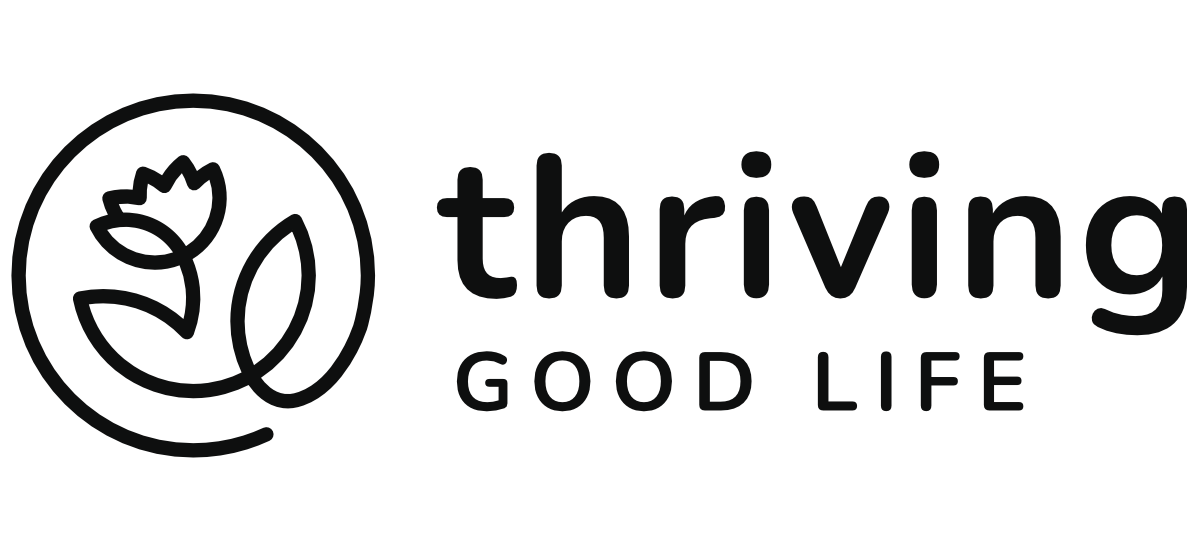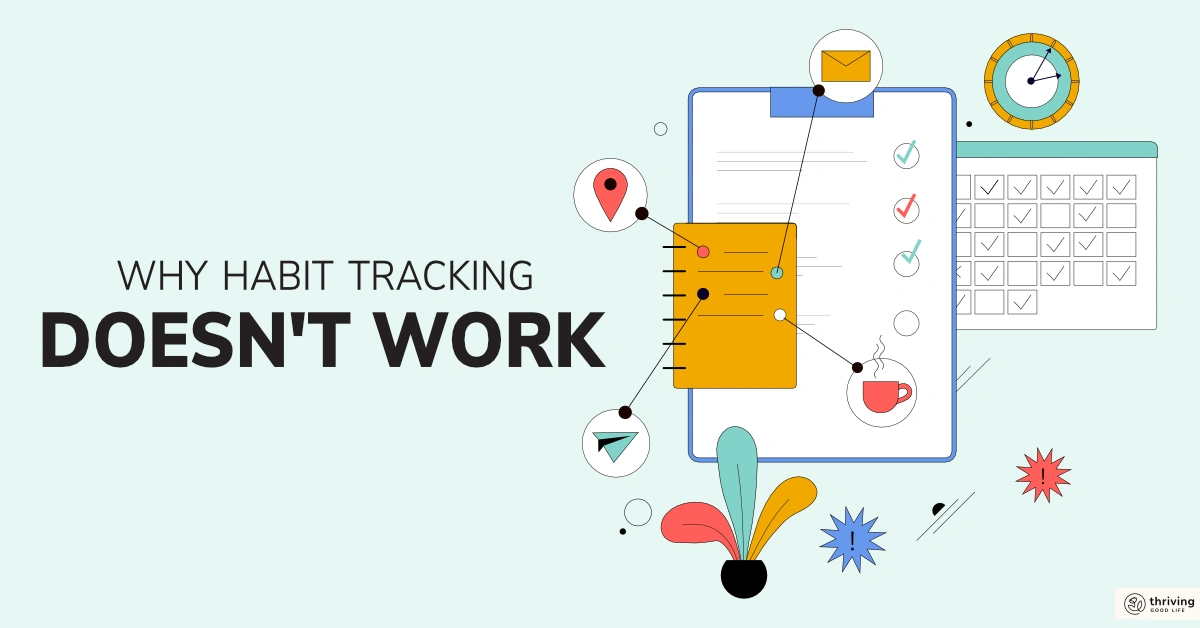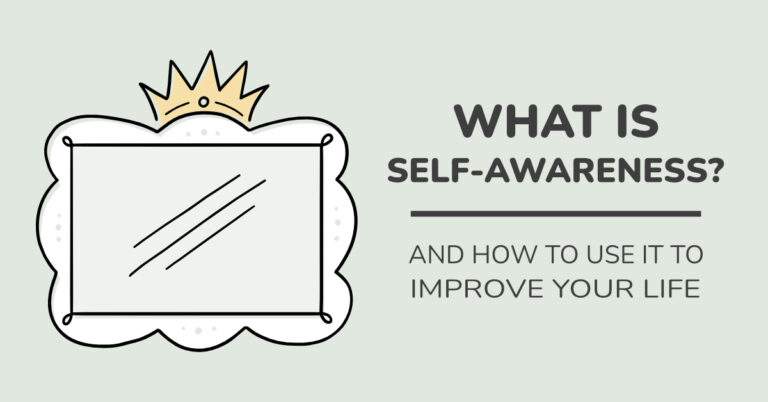Does habit tracking work?
Have you ever tried to build a new habit or achieve a goal using a habit tracker, only to find yourself falling off track again, and again, and again?
While habit tracking can be a great tool for some people, the truth is it doesn’t work for everyone.
As someone who has been prioritizing personal growth and self-work for years, I’ve tried many habit tracking methods. From apps to paper planners to bullet journaling.
I thought if I could find the ‘perfect’ system, I’d be unstoppable.
But it didn’t matter how many cutesy stickers I slapped in my journal or achievement badges I unlocked. The long-term results were always the same – a few weeks of semi-diligent tracking followed by a slow slip-slide back into my old unproductive ways.
Thankfully, I found a more sustainable and mindful way to make my habits stick.
7 Reasons Why Habit Trackers Don’t Work for Everyone
No, it’s not because you lack discipline or willpower.
The truth is, most habit trackers simply aren’t designed to account for the unique needs and preferences of each person. What seems to work seamlessly for your friend, feels like a constant uphill battle for you. If that’s how you feel, you may be committing one of the following habit sins.
And that would be a shame because habit trackers aren’t only useful for tracking new and healthy habits, they work for replacing (or breaking) bad habits too. Wouldn’t you like to be free from your bad habits?
Here are those habit sins I was talking about:
1. Not Developing the Habit of Using a Habit Tracker
Ironically, for a habit tracker to actually work for you, tracking has to become a habit itself.
A lot of people struggle with consistently logging daily, which defeats the purpose of tracking. And when you start forgetting to log everyday, you quickly lose the motivation to continue.
How to Fix This:
Make your tracker visible. I use a paper habit tracker that lives inside my paper planner. Whenever I open my planner it’s there starting back at me.
Beyond making it visible, pick a consistent time to use your tracker. Choosing the same time slot each day, like right before breakfast or as the last task before bed, allows the tracker to become cued as part of your regular schedule.
2. Not Choosing Habits That Align
When we pay attention and keep track of our habits, it becomes easier to make healthier choices 1.
But first, we need to figure out what habits we want to focus on, and what we want to improve or remove from our lives.
One of the biggest issues with habit trackers is that they often lead us to lose touch with our deeper “why” – the core values and visions driving our desired changes. We get so fixated on the shallow gratification of checking boxes that we mindlessly adopt habits disconnected from our true priorities.
The act of habit tracking becomes precisely that – an act.
A means to an end. A co-mingled set of random obligations we perform for the sake of accountability instead of positive changes rooted in our personal values.
When our habits lack that genuine connection to our goals, it’s easy for the initial enthusiasm to fade. And if we miss a couple of days of logging, that can quickly spiral into complete abandonment. The mindset becomes: “I’m off track now, so why bother to keep going?”
Real, lasting change isn’t about the surface-level satisfaction of checking random things off a list. Change has more staying power when we invest the time to deliberately design our habits. Habits that support the goals and visions of our ideal selves.
This disconnection from our larger “why” is why we tend to fall off the tracking bandwagon so easily.
How to Fix This:
Think about what matters most to you.
Write down a list of goals or intentions that represent your core values and aspirations. Now determine what habits you need to adopt to reach them.
3. Trying to Track Too Much at Once
And on that note of random checklist items, we’re choosing too many things to track at once, which isn’t realistic way to maintain habit progression. For every new habit we attempt the form there needs to be some sort of plan on how to implement it.
Let’s take the habit of going to bed at 9pm each night.
What cue could we connect it to so our brain knows it’s “go to bed” time?
Maybe something like; “If it’s 8:40pm and I’m still pottering about, then I will start my bedtime routine.” And now we’ve got an actual plan for getting ourselves to bed on time. Simple, right?
Much better than scribbling down “go to bed earlier”.
But problems creep in when when have too many habits to plan for. If our list has 16 things we’re trying to make habitual each week, that’s 16 implementation intentions floating around in our brain. And you know what that leads to. Overwhelm.
Research shows that trying to juggle multiple goals at once reduces your motivation to stick with them 2. And that it’s best to work on one goal at a time.
But when it comes to tracking habits, if you’re choosing them correctly they’ll be a lot smaller than goals, so you could manage to track more than one item.
How to Fix This:
I track 3-4 easy to implement habits a day. That’s the sweet spot for me – manageable without becoming overwhelming.
These are small activities that I want to ritualize and make automatic, so eventually I won’t need to consciously track them anymore. Anything more than that handful starts feeling like a glorified to-do list rather than focused habit-building.
You’ll need to experiment and find your own optimal number based on what feels doable without causing you to burnout.
4. Tracking Overly Ambitious Habits
Which one of these do you think will be easier to track – a small simple action-step, or diving headfirst into an elaborate routine? The single action, without a doubt.
The more straightforward the task, the more likely you are to complete it and mark it off your list consistently. Big, complex habits set you up for failure from the jump.
So if you wanted to start a journaling habit, it’s much more realistic to begin with a modest habit such as journaling for 5 minutes a day, twice a week. It’s better than trying to overachieve by committing to an intense 30-minute brain dump in your journal every single day of the month.
That’s a surefire way to burn out quickly.
The same applies to any routine you’re looking to install.
Want to start exercising regularly? Don’t go 0 to 100 by tracking an hour-long weightlifting session 5 days a week when you’re a total beginner. Build up to that beast mode over time. Start tracking 5 squats, lunges or planks a couple of times per week at home.
Want to develop a meditation practice? Don’t try to sit crossed-legged for 45 minutes every morning. Start with 3-5 minutes. And you don’t have to sit crossed-legged if you don’t want to. Meditating in bed is okay too 3.
How to Fix This:
Focus on building small habits, or as James Clear calls them atomic habits.
Breakdown any large goals or routines into their tiniest components. Select the ones you want to prioritize, then add those to your tracker.
As the habit becomes more established in your day to day life, you can gradually increase it’s scope or frequency of over weeks and months.
5. Being Overly Focused on Monitoring Streaks
Checking off those boxes is addicting.
That dopamine hit when you look at your tracker and see an unbroken chain of daily checkmarks – that feels good. It gives you a real sense of accomplishment.
But when you miss a day? Oof, that empty box packs a punch. Not only does it feel disheartening, but that one little blip has the power to throw you off track for the rest of the week. Or longer.
The thing is, occasionally skipping a day doesn’t actually derail you that much in the long run 4. One missed day really isn’t the end of the world.
That’s where the “two-day rule” comes in to play 5.
Instead of holding yourself to an unrealistic standard of perfection, know that you’re still in the game. As long as you never let two full days lapse without doing the habit. Slip up one day? Not ideal, but no biggie – just get back on it the next day.
Being consistent doesn’t mean doing a ‘thing’ every single day.
It means committing to doing it regularly, even if or when you miss a day.
How to Fix This:
Go easy on yourself. Learn to forgive the occasional mess up. Yes, that’s easier said than done, but imagine you’re talking to yourself as though you were talking to your best friend who made the same mistake. Would you beat them up for it? No. You’d encourage them to keep going.
Stay motivated by following “The Two Day Rule”.
If you find yourself constantly skipping, then you need to understand why it keeps happening. Review your habits to make sure they’re still aligned with your goals and the person you’re striving to become.
6. Not Reflecting on Progress
Simply tracking habits isn’t enough. You also need to routinely pause and reflect on your progress.
Building good habits calls for you to be adaptable, kind to yourself, and ready to tweak things when they aren’t panning out. Taking time to see which habits are paying off, which ones aren’t, and understanding the reasons behind both, helps you adjust your habits in a way that’s meaningful.
This reflective step is often missing in basic checkbox-style habit trackers.
How to Fix This:
Schedule time to reflect on how you’re progressing with your habits. You can do this on a weekly, or monthly basis depending on what works for you.
Incorporate journal prompts that have been specifically designed to guide your reflection. These will help you dig deeper into your experiences, making your introspection more structured and insightful.
7. Using Habit Trackers That Are Too Rigid
Many habit trackers take a one-size-fits-all approach, assuming all users simply want to check boxes. But, effective tracking allows for customization.
For some people, ticking a box isn’t enough – they want to record more granular numerical data like miles run, hours studied, or calories consumed. Others may prefer using different visual cues beyond just checkmarks.
A good habit tracking system gives you options so you can tailor it to your personal preferences and needs, not the other way around.
How to Fix This:
When choosing a habit tracker, don’t default to the first free generic option.
Identify what and how specifically you want to log – numbers, notes, checkmarks, shading? And how frequently you want to track – weekly, monthly, both?
Which Habit Tracker is Best for You?
There are plenty of solid choices for setting up a habit tracking system.
Tracking apps work well for people who want to log habits on the go with a phone.
Some of them even give you analytics to analyze your progress.
The downside is most of these apps tend to come with a paid subscription. If you want to avoid that ongoing monthly fee, it’s worth checking out some other options.
I’m a paper lover myself, so I use printable habit trackers. There’s something calming and intuitive about putting pen to paper that works for me. I also don’t like being constantly tethered to my phone with notifications pinging for my attention, so paper is my friend.
Another option is to combine digital with a handwritten experience. For example, if you have an iPad or another tablet with notetaking capabilities and a stylus, you can get the best of both worlds.
Write down your habits in a digital notebook and get that tactile writing experience, minus the paper clutter and in-app notifications. Plus, you get backups and syncing across devices with cloud storage.
So, what’s the best habit tracker for you?
The one that fits your lifestyle and preferences. Whether that’s an app, paper journal, printable or digital notebook, the main thing is to pick a system you’ll actually stick with long-term.
And if you can find a system that offers flexibility, guides you in choosing habits aligned with your goals and identity, provides thought-provoking journaling prompts, and builds self-awareness – well, then you’re onto a winner.
That’s exactly what I had in mind when I created the Habit Tracker Journal Workbook.
It’s a printable habit tracker, but it’s also digital too.
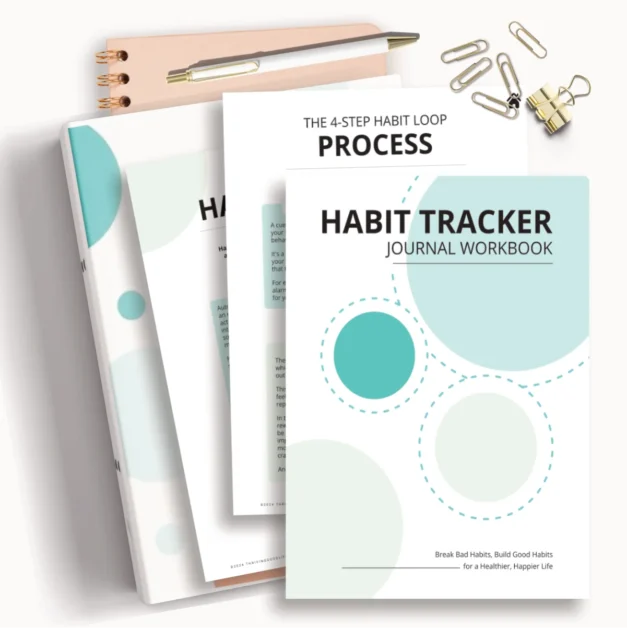
FROM THE SHOP
Break Bad Habits. Build New And Improved Ones.
If you’re tired of not sticking to your habits, this workbook is for you.
The Habit Tracker Journal Workbook
This workbook is designed to set you up for lasting success.
It takes you through an eye-opening exercise to understand the cues and triggers that drive your current bad habits – the ones you want to replace.
From there, you’ll work through self-discovery prompts to pinpoint habits that genuinely align with your goals, values, and vision for your ideal self.
With this self-awareness, you’ll develop a system for creating meaningful new habits – no more trying to force habits that don’t stick.
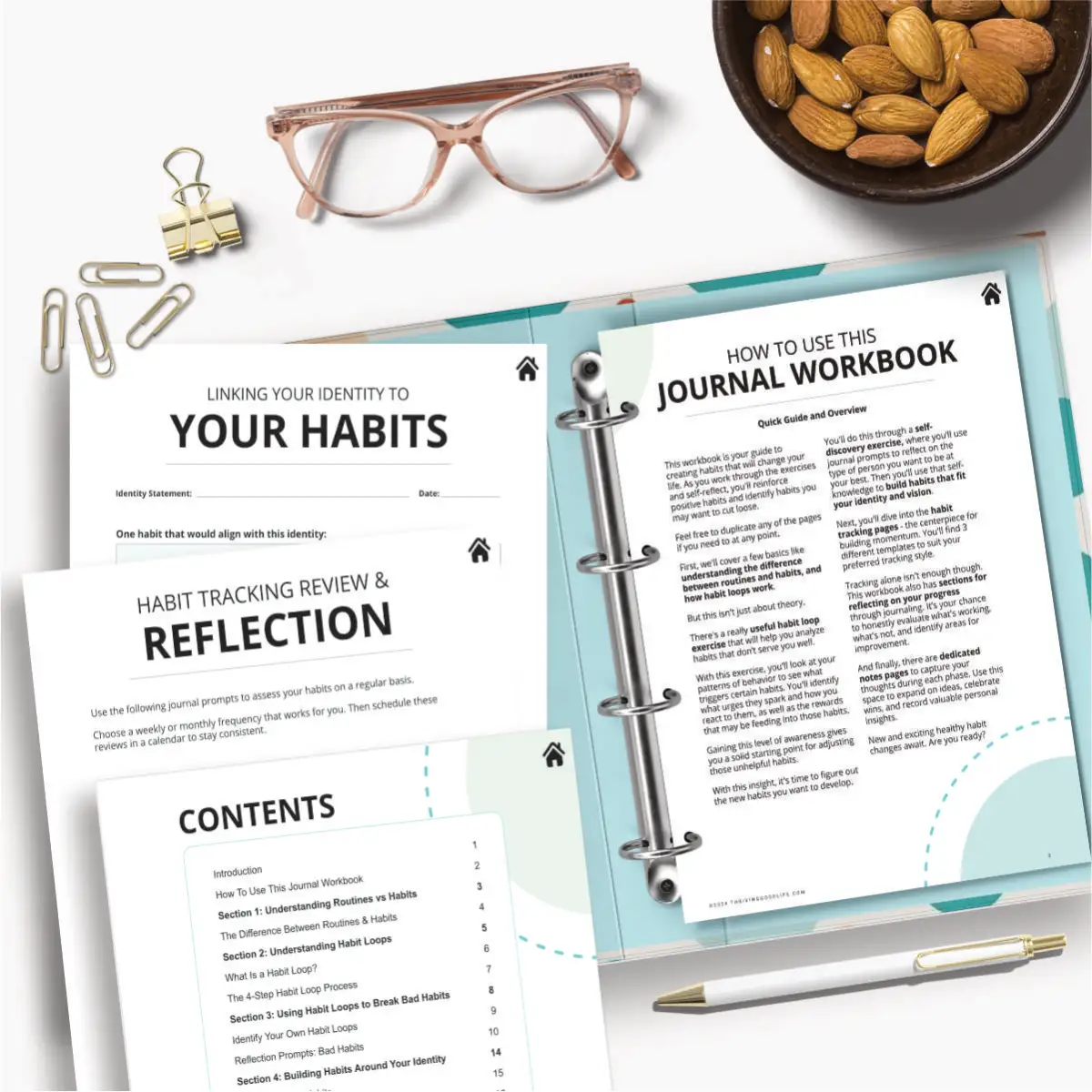
But let’s be real – even with the best intentions, stuff will come up that test your willpower. That’s why the workbook has you set up an ‘If/Then’ plan to prepare for inevitable roadblocks.
You’re essentially saying to yourself: ‘If THIS situation happens, then I’ll do THAT instead.’ Kind of like having a personalized toolkit to combat obstacles.
For example, let’s say one of your habits centers around you staying healthy.
IF your coworker brings in donuts, THEN you’ll grab a handful of unsalted nuts stashed in your drawer as a healthier fix and remind yourself that the sugar in donuts is evil.
IF you had planned to go to the gym after work but you’re dead tired, THEN you’ll do 10 minutes of YouTube yoga stretches at home instead. Workout goal accomplished.
The workbook has templates and examples to walk you through this strategy.
It also includes tracking pages and journaling sections.
Top Benefits of Using this Habit Workbook
It’s rooted in science: It takes what we know about habit-building from evidence-based sources and puts it into practical action steps that you can apply to your life. You’ll get a little bit of brain science to steer you in the right direction, along with tips that actually fit into your day-to-day life.
Helps decode bad habits: There’s a handy “habit loop” exercise that breaks down bad habits by looking at the triggers, urges, actions, and rewards associated with them. Getting real about what’s fueling those behaviors means you can make actual changes, not merely go through the motions.
You’ll also get a chance to journal and reflect on the person you want to be. Then use those insights to deliberately pick new habits that fit your vision for your best self.
Personalized tracking: There are three different habit tracking templates to suit your preferred tracking style. Because not everyone likes ticking boxes. Some people like to color or shade in the boxes, while others like to record metrics such as pages read, minutes meditated or miles run each day and week.
Guided self-reflection: This is your chance to check-in with yourself with thought-provoking journal prompts. To honestly assess your progress, learn from setbacks, and make adjustments to keep going.
Multi-format access: Flexibility is key, and this workbook caters to different preferences—whether you prefer digitally writing on a tablet with a stylus, typing on PC or phone, or the tactile feel of pen on paper.

FROM THE SHOP
Break Bad Habits. Build New And Improved Ones.
If you’re tired of not sticking to your habits, maybe it’s time to try a more mindful tool for habit tracking.
Tips for Making the Most of This Workbook
Keep it in your line of sight: Having it someplace you’ll constantly see acts as a persistent reminder. Your nightstand, desk, wherever. But make sure it’s not placed in ‘out of sight, out of mind’ territory.
Piggyback on existing habits: Try linking a new habit to something you already do daily, like writing a line in your journal right after you brush your teeth in the morning. It’ll start feeling like a natural ritual.
Schedule fun rewards: Set up little treats for hitting milestones along the journey. Nothing major. For me if I get to the end of the week and I have more days where I completed a habit than not, I see that as a win. My treat is usually something I don’t do very often, like watching a movie.
Fight the perfectionism: Reflecting on your personal growth is about the process, not creating a masterpiece. It’s okay for your entries to be messy or disjointed. The real value lies in your thoughts and insights, not in flawless handwriting or typo-free grammar. Give yourself permission to write freely, and welcome imperfection as part of the path you’re on.
Find an accountability buddy: You could pair up with a friend and compare notes each week. I have a couple of friends who check-in with each other every Monday to make sure they’ve both been exercising as they said they would. They live in different parts of the world, and this works like a charm. If you know you’ll struggle with a particular habit, this may be something you’ll find this helpful too.
Ready to start guiding positive change in your everyday routines?
Grab this workbook and start turning your habits around

FROM THE SHOP
Break Bad Habits. Build New And Improved Ones.
If you’re tired of not sticking to your habits, this workbook is for you.
Footnotes
- Gardner, B., Lally, P., & Wardle, J. (2012). Making health habitual: the psychology of “habit-formation” and general practice. British Journal of General Practice, 62(605), 664–666. https://doi.org/10.3399/bjgp12x659466
- Dalton, A., & Spiller, S. (2012). Too much of a good thing: the benefits of implementation intentions depend on the number of goals. Journal of Consumer Research, 39, 600-614. https://doi.org/10.1086/664500
- Rees, M. (2023, July 19). Meditating in bed: techniques and benefits. Medical News Today. https://www.medicalnewstoday.com/articles/how-to-meditate-in-bed#how-to-meditate
- Lally, P., Jaarsveld, C., Potts, H., & Wardle, J. (2010). How are habits formed: Modelling habit formation in the real world. European Journal of Social Psychology, 40, 998-1009. https://doi.org/10.1002/EJSP.674
- A concept popularized by Matt D’Avella an entrepreneur, author, YouTuber and podcast host focused on simple living and productivity
